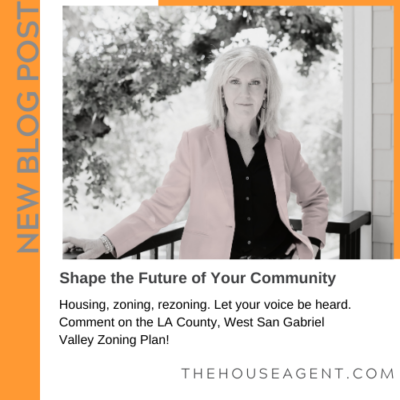 You have an opportunity to provide comments on an important Regional Plan for the Unincorporated areas of the West San Gabriel Valley in Altadena, East Pasadena-East San Gabriel, Kinneloa Mesa, La Crescenta-Montrose, San Pasqual, South Monrovia Islands, South San Gabriel, Whittier Narrows, and South El Monte Island.
You have an opportunity to provide comments on an important Regional Plan for the Unincorporated areas of the West San Gabriel Valley in Altadena, East Pasadena-East San Gabriel, Kinneloa Mesa, La Crescenta-Montrose, San Pasqual, South Monrovia Islands, South San Gabriel, Whittier Narrows, and South El Monte Island.
Dates and Timeline
- Public Review Period:
- June 27, 2024, to August 12, 2024, ending at 5:00 pm. This is the timeframe for residents to submit comments on the Draft PEIR.
- Public Meeting:
- Virtual meeting on July 18, 2024, at 6:00 pm via Zoom Webinar.
- Implementation Timeline:
- The plan outlines development over the next 20 years, integrating community feedback and ensuring phased implementation of proposed changes.
Since these County areas are interspersed among many neighboring cities in the San Gabriel Valley, residents of all of the West San Gabriel Valley cities from Glendale through Azusa along the San Gabriel mountains, West Covina through Pico Rivera to the south, and cities in between should also pay attention and provide comments since the County’s plans will affect all in this portion of the San Gabriel Valley.
Per the California Environmental Quality Act (CEQA), Los Angeles County has developed a Draft Program Environmental Impact Report (Draft PEIR) for the West San Gabriel Valley Area Plan (WSGVAP) to guide zoning and development, including the building of substantial additional housing over the next 20 years.
Opportunities to Provide Input on the West San Gabriel Valley Zoning Plan:
The formal public review period for the Draft PEIR began on June 27, 2024, and ends on August 12, 2024, at 5:00 pm.
When submitting written comments, reference the Project name: (DRAFT PROGRAM ENVIRONMENTAL IMPACT REPORT FOR THE WEST SAN GABRIEL VALLEY AREA PLAN) and number (PRJ2023-003982).
Comments should include your contact information and identify specific topics of environmental concern. The County prefers email to info@planning.lacounty.gov.
Comments can also be submitted via regular mail to: Evan Sensibile, Regional Planner, County of Los Angeles, Department of Regional Planning, 320 West Temple Street, 13th Floor, Los Angeles, CA 90012, Tel: (213) 974-6425.
A public meeting about the project will be held virtually, online via Zoom Webinar, on Thursday, July 18th at 6:00 pm. Details are at planning.lacounty.gov/long-range-planning/wsgvap/documents.
West San Gabriel Planning Area
The WSGV Planning Area is 23.2 square miles within the southeast portion of Los Angeles County and includes nine separate unincorporated County communities: Altadena, East Pasadena-East San Gabriel, Kinneloa Mesa, La Crescenta-Montrose, San Pasqual, South Monrovia Islands, South San Gabriel, Whittier Narrows, and South El Monte Island. The proposed plan will affect you if you live in or near one of these areas. Los Angeles County urges residents to provide comments to the County on this important Project’s Draft PEIR. The plan addresses changes to Land Use, including Housing, Mobility, Conservation, and Open Space; Public Services and Facilities; Economic Development; and Historic Preservation. The WSGVAP updates and incorporates the existing Altadena Community Plan into the Area Plan. The East Pasadena-East San Gabriel, La Crescenta-Montrose, Altadena, Chapman Woods, and South San Gabriel Community Standards Districts (CSDs) are proposed to be updated, reorganized, and consolidated into the Area Plan.
Specifically for housing, the WSGVAP anticipates facilitating approximately 10,874 new housing units, 25,954 new residents, and 16,243 new jobs within these nine communities over the next 20 years.
The WSGVAP plan proposes to:
- rezone certain A-1 parcels that are not currently used for agricultural purposes to R-A (Residential Agricultural), R-1 (Single-Family Residence), R-2 (Two-Family Residence), or OS (Open Space)
- rezone certain areas identified for growth primarily along commercial corridors and major roadways as well as within select areas near commercial corridors and transit with existing low residential density
- rezone hazard areas and areas within or adjacent to natural resource areas to preserve these areas and to limit impacts from future development
- Amend the Planning and Zoning Code to improve neighborhood walkability, create communal space, improve community character and design, increase neighborhood greening, increase access to transit, and promote land use compatibility.
Changes are proposed for ridgelines, structures, parking requirements, and many other aspects of residential and commercial structures. Even with the implementation of feasible mitigation measures, the impacts will be significant and unavoidable. These include Aesthetics, Air Quality, Biological Resources, cultural resources, Noise, and Transportation.
A digital copy of the Draft PEIR is available on the Project website (under “Advance Planning Projects”). Printed copies are also available at various public libraries in Altadena, Pasadena (Hastings), La Crescenta, Montrose, El Monte, South El Monte, Duarte, San Gabriel, Temple City, and Montebello.
Written by Dr. Ranajit (Ron) Sahu, a resident of Alhambra, is an engineer and environmental consultant.
Key Take Aways:
- Substantial Housing Development:
The plan anticipates 10,874 new housing units, accommodating approximately 25,954 new residents and creating 16,243 new jobs over the next 20 years. This addresses the housing shortage and promotes economic growth.
- Community-Specific Zoning Changes:
Rezoning agricultural parcels not currently in use for agriculture to various residential and open space designations can significantly impact community character and land use.
- Public Input and Participation:
Residents have the opportunity to provide comments on the Draft PEIR until August 12, 2024, and attend a virtual public meeting on July 18, 2024. Active community involvement can influence the final plan.
- Environmental and Community Impact:
Proposed amendments aim to improve walkability, communal spaces, and neighborhood greening, enhancing quality of life. However, significant unavoidable impacts on aesthetics, air quality, biological and cultural resources, noise, and transportation are acknowledged.

